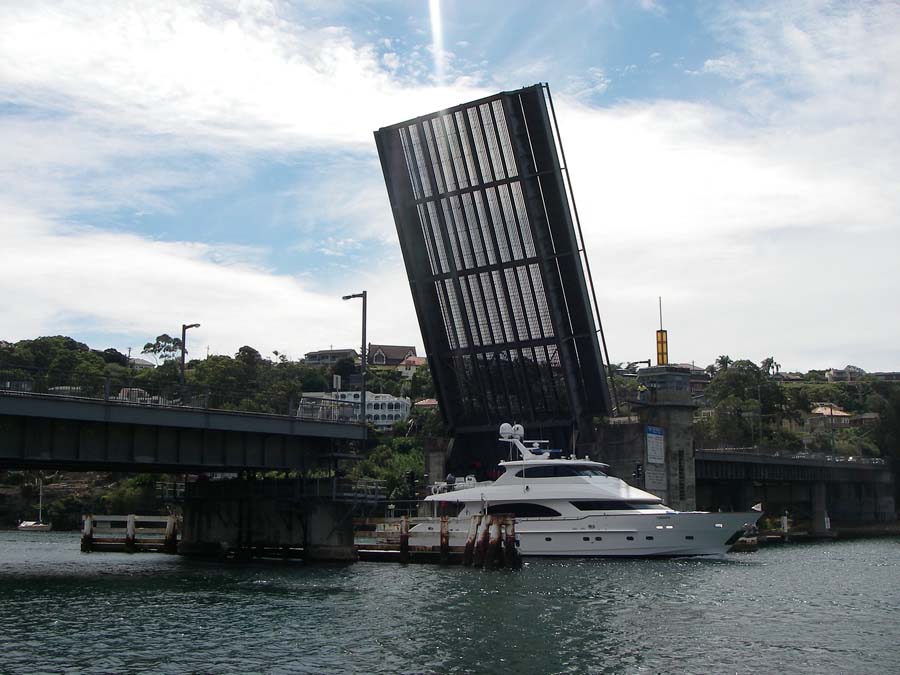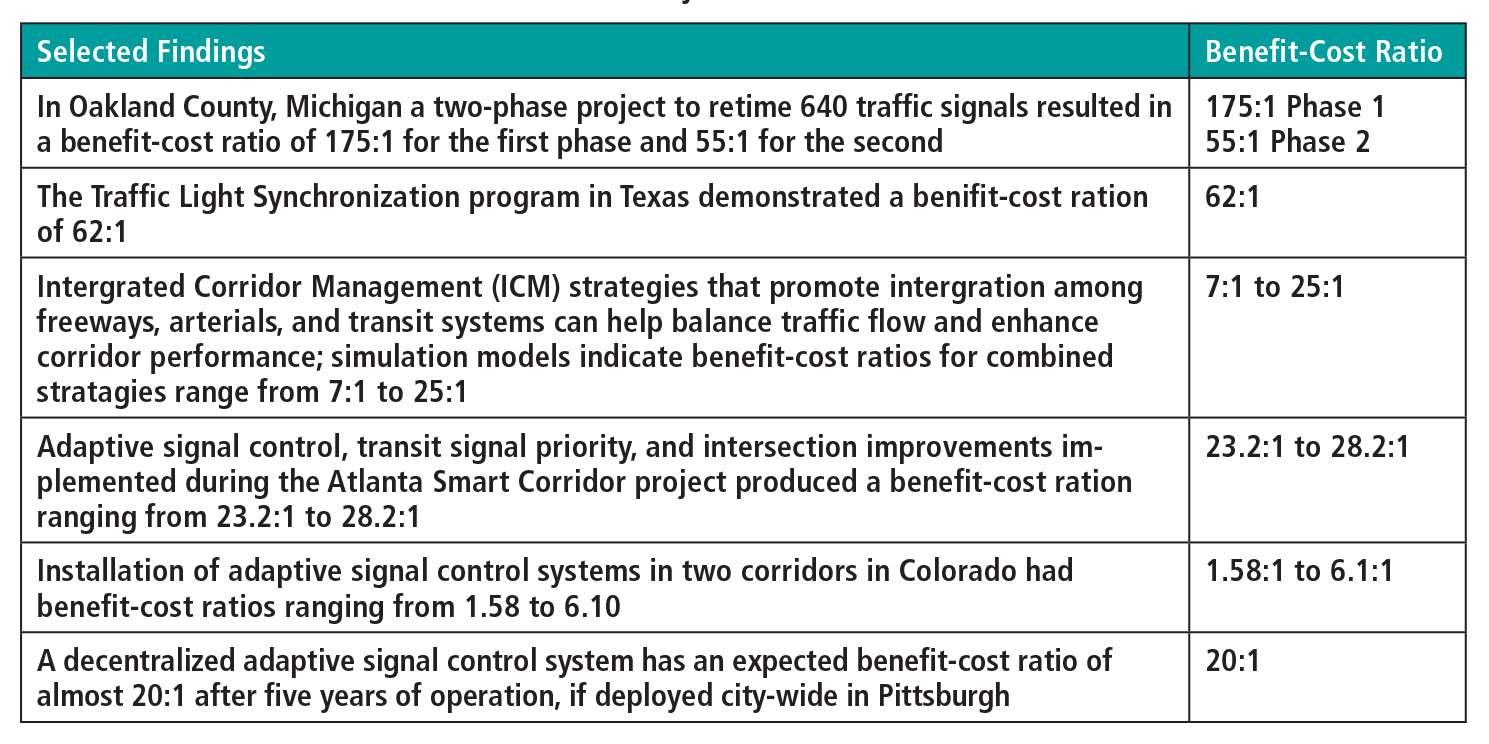Australian study quantifies the benefits of SCATS to the motorists, the environment and the economy. Opportunity weekday cost savings potential of some AUD16 million (US$15.2 million) has emerged from rigorous analysis of a one-day study of Australia’s Sydney Coordinated Adaptive Traffic System (SCATS) in operation. This represents 27% of the total cost of a real alternative semi-adaptive traffic control. The estimated indicative annual weekday-based value is AUD3,900 million (US$3,705 million) or 0.9% of t

Bridge openings were accounted for in the modelling.
Australian study quantifies the benefits of SCATS to the motorists, the environment and the economy
Opportunity weekday cost savings potential of some AUD16 million (US$15.2 million) has emerged from rigorous analysis of a one-day study of Australia’s Sydney Coordinated Adaptive Traffic System (SCATS) in operation. This represents 27% of the total cost of a real alternative semi-adaptive traffic control. The estimated indicative annual weekday-based value is AUD3,900 million (US$3,705 million) or 0.9% of the annual gross state product of the Australian state of New South Wales.
A recent SCATS and the Environment (SatE) study set out to show the transport, environmental and economic value that SCATS delivers to the road stakeholders of New South Wales. It assessed the performance of 21 SCATS-controlled intersections across 24 hours on a key, strategic route in Sydney, the state capital of New South Wales and the most populous city in Australia.
It compared SCATS operation with a realistic alternative, representing a reactive, semi-adaptive, fixed-time system. When using SCATS the results demonstrated indicative reductions of 28% in travel times and 25% in traffic stops. This would lead to a 15% reduction in CO2 and PM10 and a slightly smaller (13%) drop in NOx emissions from vehicles, resulting in total savings of AUD 142,051(US$134,949) for the weekday being observed.
The initiative sprang from an approach by the United Nations to New South Wales’ recently redesignated6722 Roads and Maritime Services (RMS) – to share its expertise in using adaptive traffic control to manage the carbon emissions generated by road vehicles. The contact stimulated the RMS into initiating the SatE study to develop the appropriate evidence.
A key issue was how to measure SCATS’ operational value. Recent RMS investigations have highlighted the difficulty of measuring traffic performance in the real world and attributing this to known changes in traffic signals policy. The challenge lies in distinguishing between the influences of traffic system policy changes from natural variations in traffic demand and from behaviour.
The solution adopted for the SatE study was to use calibrated traffic simulation as an estimating surrogate for real world measurement. The study authentically operated a real SCATS system within a carefully constructed and calibrated traffic simulation model.
It used SCATSIM, the software that allows SCATS authentically to operate interfacing to a compatible traffic network simulation model. Developed by RMS, SCATSIM supports the continuous improvement of SCATS set UPS.
Researchers were confident of the ability of SCATSIM to ensure that the operation of SCATS within a simulated environment was realistic. So for SatE they used SCATSIM to model the real-life SCATS installations in an equivalent virtual road network constructed in traffic simulation.
They modelled the simulated traffic environment including vehicles, pedestrians and passengers getting on and off buses - using NSW-headquartered infrastructure analysts Azalient’s Commuter application. Emission factors were derived from Euro I and II standards (Australia has been harmonising its own certification process for new motor vehicles with European ones since the early 2000s).
Advice from the RMS was that these were conservative for Australian conditions, given that the country’s vehicle fleet is older than most European ones. Following this, the SatE environmental results can be considered as similarly conservative.
The SatE study modelled a critical 6.5km-corridor - Military Road and Spit Road - on Sydney’s North Shore, part of the main arterial route connecting the city’s northern beaches residential areas with its central business district. This is used by some 80,000 vehicles each working day, including buses moving around 60,000 commuting passengers.
A linear main route line, with a maximum typical gradient of 7.3% ranging from 5m to 89m above sea level and side streets modelled as ‘stubs’. It contains 21 SCATS-controlled intersections and 39 priority ones, including non-signalised side streets. Important infrastructural characteristics that were modelled included the timing of the tidal flow reversible lane, the scheduled daily openings of the bascule Spit Bridge over the city’s Middle Harbour and operational hours for the parking restrictions.
Modelling of a complete 24-hour period, starting at 0300hrs, covered over 169,000 private vehicle trips, 1,000 public transport journeys, and 43,000 pedestrian and bus boardings and alightings.
The project team decided to use SCATS’ configured Fallback mode as a valid ‘contrary’ traffic control policy for comparison with normal operation. The base scenario used the SCATS’ adaptive Masterlink mode which generates the integrated traffic responsive operation. Masterlink is standard on SCATS, with Fallback serving as a simpler mode, manually maintained to be automatically invoked the event of a systems fault such as a loss of communications. Fallback uses fixed maximum phase times with vehicle actuation demanding and extending phases using lane detectors. The reported SCATS performance improvements are what Masterlink delivered above the Fallback alternative.
The decision enabled the comparison of normal SCATS operation with an alternative, semi-fixed time, well-maintained and reliable approach to traffic control. It also ensured that the SatE study produced immediate and tangible information value for RMS’ business.
Deploying SCATSIM required the calibration of non-SCATS traffic behaviour, including the measurement of:
• Total traffic flows for each hour at each approach, by SCATS detectors located at most intersection stop-lines in most lanes;
• Vehicle travel time from incidental toll tags on private and public vehicles that happened to be travelling the non-tolled corridor, using previously installed electronic readers for in-bound journeys; and
• Bus travel and at-stop dwell times, using GPS devices installed for SCATS dynamic bus signal priority (which is not activated on the chosen corridor for operational reasons).
The necessary validation of SCATS behaviour emerged from comparing traffic signal phase lengths recorded by SCATS in the real-world against those recorded in the base simulation.
In a subsequent extrapolation of the SatE results, simple regression analysis and flow proportioning has given the annual weekday performance estimate of AUD16 million. This covers the 2,814 intersections in the metropolitan Sydney region and represents a large proportion of the New South Wales road network that is under SCATS control. This model has been generated by Azalient Commuter from New South Wales RMS data.
The extrapolated output shows that SCATS delivered improvements in intersection vehicle performance across all analysed metrics. These included a 23% decrease in stops per km contributing to a 25% increase in speed. Furthermore, for the distance travelled, CO2 emissions were reduced by 8%, with NOx down by16% less and PM10 cut by 21%.
Steven Shaw, executive manager, transport strategy and systems with RMS says: “The final result of the study demonstrates that SCATS is a sophisticated adaptive and optimising traffic management system that delivers significant value to road network stakeholders. The study will, I hope, be useful for those wanting a defensible reference that indicates the contributions delivered by a SCATS installation at a corridor level.”
The RMS now plans a further stage of the extrapolation study using more sophisticated regression techniques. In particular, it wants better to capture the variation of intersection characteristics across New South Wales.
Onward from Tokyo
Establishment of IBEC (the International Benefits, Evaluation and Costs Working Group) as a legal entity, and an emphasis on in-depth analysis of ITS schemes, were highlights of the organisation’s annual general meeting, held during the 20136456 ITS World Congress in Tokyo.
Achieving legal status will enable the 500+-strong organisation to secure funding for research projects on evaluation. This, said chair Tom Kern, executive vice-president of560 ITS America, will enhance IBEC’s known capability to deliver high-quality work, while maintaining its reputation as a neutral platform within the ITS industry. Management committee member Meng Lu, of the Netherlands Institute for Advanced Logistics, is developing a list of potential projects. An IBEC-organised special interest session ‘Evaluation of Cooperative and Automated Driving’ drew particular interest highlighting concerns about the need to account credibly for safety benefits in automated systems and where to lay blame for accidents.
Another session ‘Why (not) Evaluate ITS?’ reflected that while ex-ante data continues to be collected, ex-post data is currently less likely to be surveyed. Reasons for this included being ‘too risky’ and fears that the results would not show scheme in a favourable and could embarrass funding agencies. Proposed solutions included requiring evaluation as a prerequisite for funding and an identified accountability trail. But, IBEC management committee vice-chair Keith Keen told1846 ITS International: “The debate needs to continue beyond the walls of a world congress session room.”
Other IBEC sessions included ‘Comparing ITS Evaluation Methodologies Internationally: Challenges and Common Denominators’, ‘Making Cost-Benefit Analysis for the Policy, Operator and Traveller Cases’ and ‘Drastic Measures for the Middle East and South Africa to Reach Zero Crash Fatalities’.
Opportunity weekday cost savings potential of some AUD16 million (US$15.2 million) has emerged from rigorous analysis of a one-day study of Australia’s Sydney Coordinated Adaptive Traffic System (SCATS) in operation. This represents 27% of the total cost of a real alternative semi-adaptive traffic control. The estimated indicative annual weekday-based value is AUD3,900 million (US$3,705 million) or 0.9% of the annual gross state product of the Australian state of New South Wales.
A recent SCATS and the Environment (SatE) study set out to show the transport, environmental and economic value that SCATS delivers to the road stakeholders of New South Wales. It assessed the performance of 21 SCATS-controlled intersections across 24 hours on a key, strategic route in Sydney, the state capital of New South Wales and the most populous city in Australia.
It compared SCATS operation with a realistic alternative, representing a reactive, semi-adaptive, fixed-time system. When using SCATS the results demonstrated indicative reductions of 28% in travel times and 25% in traffic stops. This would lead to a 15% reduction in CO2 and PM10 and a slightly smaller (13%) drop in NOx emissions from vehicles, resulting in total savings of AUD 142,051(US$134,949) for the weekday being observed.
The initiative sprang from an approach by the United Nations to New South Wales’ recently redesignated
A key issue was how to measure SCATS’ operational value. Recent RMS investigations have highlighted the difficulty of measuring traffic performance in the real world and attributing this to known changes in traffic signals policy. The challenge lies in distinguishing between the influences of traffic system policy changes from natural variations in traffic demand and from behaviour.
The solution adopted for the SatE study was to use calibrated traffic simulation as an estimating surrogate for real world measurement. The study authentically operated a real SCATS system within a carefully constructed and calibrated traffic simulation model.
It used SCATSIM, the software that allows SCATS authentically to operate interfacing to a compatible traffic network simulation model. Developed by RMS, SCATSIM supports the continuous improvement of SCATS set UPS.
Researchers were confident of the ability of SCATSIM to ensure that the operation of SCATS within a simulated environment was realistic. So for SatE they used SCATSIM to model the real-life SCATS installations in an equivalent virtual road network constructed in traffic simulation.
They modelled the simulated traffic environment including vehicles, pedestrians and passengers getting on and off buses - using NSW-headquartered infrastructure analysts Azalient’s Commuter application. Emission factors were derived from Euro I and II standards (Australia has been harmonising its own certification process for new motor vehicles with European ones since the early 2000s).
Advice from the RMS was that these were conservative for Australian conditions, given that the country’s vehicle fleet is older than most European ones. Following this, the SatE environmental results can be considered as similarly conservative.
The SatE study modelled a critical 6.5km-corridor - Military Road and Spit Road - on Sydney’s North Shore, part of the main arterial route connecting the city’s northern beaches residential areas with its central business district. This is used by some 80,000 vehicles each working day, including buses moving around 60,000 commuting passengers.
A linear main route line, with a maximum typical gradient of 7.3% ranging from 5m to 89m above sea level and side streets modelled as ‘stubs’. It contains 21 SCATS-controlled intersections and 39 priority ones, including non-signalised side streets. Important infrastructural characteristics that were modelled included the timing of the tidal flow reversible lane, the scheduled daily openings of the bascule Spit Bridge over the city’s Middle Harbour and operational hours for the parking restrictions.
Modelling of a complete 24-hour period, starting at 0300hrs, covered over 169,000 private vehicle trips, 1,000 public transport journeys, and 43,000 pedestrian and bus boardings and alightings.
The project team decided to use SCATS’ configured Fallback mode as a valid ‘contrary’ traffic control policy for comparison with normal operation. The base scenario used the SCATS’ adaptive Masterlink mode which generates the integrated traffic responsive operation. Masterlink is standard on SCATS, with Fallback serving as a simpler mode, manually maintained to be automatically invoked the event of a systems fault such as a loss of communications. Fallback uses fixed maximum phase times with vehicle actuation demanding and extending phases using lane detectors. The reported SCATS performance improvements are what Masterlink delivered above the Fallback alternative.
The decision enabled the comparison of normal SCATS operation with an alternative, semi-fixed time, well-maintained and reliable approach to traffic control. It also ensured that the SatE study produced immediate and tangible information value for RMS’ business.
Deploying SCATSIM required the calibration of non-SCATS traffic behaviour, including the measurement of:
• Total traffic flows for each hour at each approach, by SCATS detectors located at most intersection stop-lines in most lanes;
• Vehicle travel time from incidental toll tags on private and public vehicles that happened to be travelling the non-tolled corridor, using previously installed electronic readers for in-bound journeys; and
• Bus travel and at-stop dwell times, using GPS devices installed for SCATS dynamic bus signal priority (which is not activated on the chosen corridor for operational reasons).
The necessary validation of SCATS behaviour emerged from comparing traffic signal phase lengths recorded by SCATS in the real-world against those recorded in the base simulation.
In a subsequent extrapolation of the SatE results, simple regression analysis and flow proportioning has given the annual weekday performance estimate of AUD16 million. This covers the 2,814 intersections in the metropolitan Sydney region and represents a large proportion of the New South Wales road network that is under SCATS control. This model has been generated by Azalient Commuter from New South Wales RMS data.
The extrapolated output shows that SCATS delivered improvements in intersection vehicle performance across all analysed metrics. These included a 23% decrease in stops per km contributing to a 25% increase in speed. Furthermore, for the distance travelled, CO2 emissions were reduced by 8%, with NOx down by16% less and PM10 cut by 21%.
Steven Shaw, executive manager, transport strategy and systems with RMS says: “The final result of the study demonstrates that SCATS is a sophisticated adaptive and optimising traffic management system that delivers significant value to road network stakeholders. The study will, I hope, be useful for those wanting a defensible reference that indicates the contributions delivered by a SCATS installation at a corridor level.”
The RMS now plans a further stage of the extrapolation study using more sophisticated regression techniques. In particular, it wants better to capture the variation of intersection characteristics across New South Wales.
Onward from Tokyo
Establishment of IBEC (the International Benefits, Evaluation and Costs Working Group) as a legal entity, and an emphasis on in-depth analysis of ITS schemes, were highlights of the organisation’s annual general meeting, held during the 2013
Achieving legal status will enable the 500+-strong organisation to secure funding for research projects on evaluation. This, said chair Tom Kern, executive vice-president of
Another session ‘Why (not) Evaluate ITS?’ reflected that while ex-ante data continues to be collected, ex-post data is currently less likely to be surveyed. Reasons for this included being ‘too risky’ and fears that the results would not show scheme in a favourable and could embarrass funding agencies. Proposed solutions included requiring evaluation as a prerequisite for funding and an identified accountability trail. But, IBEC management committee vice-chair Keith Keen told
Other IBEC sessions included ‘Comparing ITS Evaluation Methodologies Internationally: Challenges and Common Denominators’, ‘Making Cost-Benefit Analysis for the Policy, Operator and Traveller Cases’ and ‘Drastic Measures for the Middle East and South Africa to Reach Zero Crash Fatalities’.











